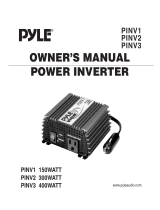2R
Important Safety Instructions
Location Warnings
• The Inverter must be located in an enclosed compartment,
shielded from outside weather conditions.
• Although your Inverter is moisture resistant, it is NOT water-
proof. Flooding the unit with water will cause it to short circuit
and could cause personal injury due to electric shock. Never
immerse the unit, and avoid any area where standing water might
accumulate. Mounting should be in the driest location available.
• Leave a minimum of 2" clearance at front and back of the
Inverter for proper ventilation. To avoid automatic Inverter
shutdown due to overtemperature, any compartment that
contains the Inverter must be properly ventilated with adequate
outside air flow. The heavier the load of connected equipment,
the more heat will be generated by the unit.
• Do not install the Inverter directly near magnetic storage media,
as this may result in data corruption.
• Do not install near flammable materials, fuel, chemicals or gasses
Battery Connection Warnings
• The Inverter will not operate (with or without utility power)
until batteries are connected.
• Multiple battery systems must be comprised of batteries of
identical voltage, age, amp-hour capacity and type.
• Because explosive hydrogen gas can accumulate near batteries
if they are not kept well ventilated, your batteries should not be
installed in a “dead air” compartment. Ideally, any compartment
would have some ventilation to outside air.
• Sparks may result during final battery connection. Always
observe proper polarity as batteries are connected.
• Do not allow objects to contact the two DC input terminals. Do
not short or bridge these terminals together. Serious personal
injury or property damage could result.
Equipment Connection Warnings
Do not use a Tripp Lite Inverter in life support or healthcare
applications where a malfunction or failure of a Tripp Lite
Inverter could cause failure of, or significantly alter the per-
formance of, a life support device or medical equipment.
• You may experience uneven performance results if you connect
a surge suppressor, line conditioner or UPS system to the output
of the Inverter.
• Do not modify the Inverter’s plug or receptacle in a way that
eliminates its ground connection. Do not use power adapters
that will eliminate the plug’s ground connection.
• Connect your Inverter only to a properly grounded AC power
outlet. Do not plug the unit into itself; this will damage the
device and void your warranty.
Operation Warnings
• Your Inverter does not require routine maintenance. Do not open
the device for any reason. There are no user serviceable parts inside.
• Potentially lethal voltages exist within the Inverter as long as
the battery supply and/or AC input are connected. During any
service work, the battery supply and AC input connection (if
any) should therefore be disconnected.
• Do not connect or disconnect batteries while the Inverter is
operating in either inverting or charging mode. Dangerous arcing
may result. Operating Mode Switch should be in the OFF position.
SAVE THESE INSTRUCTIONS!
This manual contains important instructions and warnings that should be followed during the installation, operation and storage of all
Tripp Lite Inverters.
Limited Warranty
Tripp Lite warrants its Inverters to be free from defects in materials and workmanship for a 30 month period from the date of retail purchase by end user.
Tripp Lite’s obligation under this warranty is limited to repairing or replacing (at its sole option) any such defective products. To obtain service under this warranty you must obtain a Returned Material
Authorization (RMA) number from Tripp Lite or an authorized Tripp Lite service center. Products must be returned to Tripp Lite or an authorized Tripp Lite service center with transportation charges
prepaid and must be accompanied by a brief description of the problem encountered and proof of date and place of purchase. This warranty does not apply to equipment which has been dam-
aged by accident, negligence or misapplication or has been altered or modified in any way, including opening of the unit’s casing for any reason. This warranty applies only to the original pur-
chaser who must have properly registered the product within 10 days of retail purchase.
EXCEPT AS PROVIDED HEREIN, TRIPP LITE MAKES NO WARRANTIES, EXPRESS OR IMPLIED, INCLUDING WARRANTIES OF MERCHANTABILITY AND FITNESS FOR A PARTICU-
LAR PURPOSE. Some states do not permit limitation or exclusion of implied warranties; therefore, the aforesaid limitation(s) or exclusion(s) may not apply to the purchaser.
EXCEPT AS PROVIDED ABOVE, IN NO EVENT WILL TRIPP LITE BE LIABLE FOR DIRECT, INDIRECT, SPECIAL, INCIDENTAL OR CONSEQUENTIAL DAMAGES ARISING OUT OF THE
USE OF THIS PRODUCT, EVEN IF ADVISED OF THE POSSIBILITY OF SUCH DAMAGE. Specifically, Tripp Lite is not liable for any costs, such as lost profits or revenue, loss of equipment,
loss of use of equipment, loss of software, loss of data, costs of substitutes, claims by third parties, or otherwise.
Tripp Lite has a policy of continuous improvement. Specifications are subject to change without notice.
WARRANTY REGISTRATION
Visit www.tripplite.com/warranty to
register the warranty of your new
Tripp Lite product. You'll be automatically
entered into a drawing for a chance to
win a FREE Tripp Lite product!*
* No purchase necessary. Void where prohibited.
Some restrictions apply. See website for details.
















